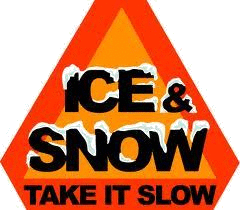Winter Safety Review
• Knowledge: Before leaving home, find out about the driving conditions. Safe drivers know the weather, and their limits. If the weather is bad remember, Ice and Snow, Take it slow, or just don’t go.
• Clear: Remove any snow on your vehicle’s windows, lights, brake lights and signals. Make sure you can see and be seen.
• Inspect: Check your vehicle’s tires, wiper blades, fluids, lights, belts and hoses. A breakdown is bad on a good day and dangerous on a bad-weather day.
• Time: Leave plenty of time to reach your destination safely. It’s not worth putting yourself and others in a dangerous situation just to be on time.
• First Snow or Ice: Drivers often aren’t prepared for winter driving and forget to take it slow. Remember to drive well below the posted speed limit and leave plenty of room between cars.
• Black Ice: Roads that seem dry may actually be slippery – and dangerous. Take it slow when approaching intersections, off-ramps, bridges or shady areas – all are hot spots for black ice. Remember, Ice and Snow, Take it Slow.
• Limited Visibility: Stay attentive and reduce speed. Know what’s going on around you.
• Four-Wheel Drive: On snow and ice, go slowly, no matter what type of vehicle you drive. Even if you have an SUV with four-wheel drive you may not be able to stop any faster, or maintain control any better, once you lose traction. Four-wheel drive may get you going faster, but it won’t help you stop sooner.
• Distance: Give snowplows room to work. The plows are wide and can cross the centerline or shoulder. Don’t tailgate and try not to pass. If you must pass, take extreme caution and beware of the snow cloud.
• Speed: Snowplows travel below the posted speed limit. Be patient. Allow plenty of time to slow down. Remember, Ice and Snow, Take it Slow.
• Vision: A snowplow operator’s field of vision is restricted. You may see them, but they don’t always see you. Keep your distance and watch for sudden stops or turns
• Speed: The faster you’re going, the longer it will take to stop. When accelerating on snow or ice, take it slow to avoid slipping or sliding. Ice and Snow, Take it Slow.
• Distance: Give yourself space. It takes extra time and extra distance to bring your car to a stop on slick and snowy roads. Leave extra room between you and the vehicle in front of you.
• Brake: Brake early, brake slowly, brake correctly and never slam on the brakes. If you have anti-lock brakes, press the pedal down firmly and hold it. If you don’t have anti-lock brakes, gently pump the pedal. Either way, give yourself plenty of room to stop.
• Control: When driving on ice and snow, do not use cruise control and avoid abrupt steering maneuvers. When merging into traffic, take it slow. Sudden movements can cause your vehicle to slide.
• Vision: Be aware of what’s going on well ahead of you. Actions by other vehicles will alert you to problems more quickly, and give you that split-second of extra time to react safely.


